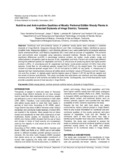| dc.contributor.author | Emmanuel, Tairo Vendeline | |
| dc.contributor.author | Njoka, Jesse T | |
| dc.contributor.author | Catherine, Lukhoba W | |
| dc.contributor.author | Lyaruu, Herbert V.M | |
| dc.date.accessioned | 2013-06-17T06:26:46Z | |
| dc.date.available | 2013-06-17T06:26:46Z | |
| dc.date.issued | 2011 | |
| dc.identifier.citation | Tairo Vendeline Emmanuel, Jesse T. Njoka, Lukhoba W. Catherine and Herbert V.M. Lyaruu (2011). Nutritive and anti-nutritive qualities of mostly preferred edible woody plants in selected drylands of Iringa District, Tanzania. Pakistan Journal of Nutrition 10 (8): 786-791, 2011 | en |
| dc.identifier.uri | http://erepository.uonbi.ac.ke:8080/xmlui/handle/123456789/34626 | |
| dc.description.abstract | Nutritional and anti-nutritional factors of preferred woody plants were evaluated in selected
drylands of Iringa District. Vangueria infausta (Burch.) and Vitex mombassae (Vatke.) identified as source
of edible fruits; Adansonia digitata (L.) and Sterculia africana (Lour.) were preferred for oil products whereas
Opilia amentacea (Roxb.) and Maerua angolensis (DC.) were used as sources of vegetables. The nutrients
and anti-nutrients were evaluated using laboratory standard methods. Results show that there were
significant differences (p<0.05) in percentage moisture content, dry matter, crude protein, crude and
carbohydrates in all species used as sources of oils, vegetables and fruits. Percent ash content was different
among the preferred species for vegetables and fruits. S. africana as oil producing plants had higher protein
content (<25%). O. amentacea and M. angolensis had higher crude protein percent (14-34%) than other
species. Crude fiber for all preferred species ranged from 9-27.6% on dry weight basis. The crude lipid
content of preferred species ranged from 1.2% for fruit plants to 6.80% for oily plants. V. infausta and A.
digitata had high Carbohydrates whereas all edible plants had higher values of Potassium and low Copper,
Iron and Zinc content. A. digitata seeds had the highest value of Vitamin C (57.31 mg/100 dry weight) and
low levels of tannins and phenols. This study concludes that wild plants are nutritious and have adequate
nutrients and levels of anti-nutrients are below the toxic levels. Consequently, use of wild food plants could
provide a possible source of food security in Iringa District. | en |
| dc.language.iso | en | en |
| dc.title | Nutritive and anti-nutritive qualities of mostly preferred edible woody plants in selected drylands of Iringa District, Tanzania | en |
| dc.type | Article | en |
| local.publisher | Department of Land Resources and Agricultural Technology, University of Nairobi, Kenya | en |
| local.publisher | Department of Botany, University of Dar es Salaam, Tanzania | en |
| local.publisher | Department of Biological Sciences, Chiromo, University of Nairobi, Kenya | en |

